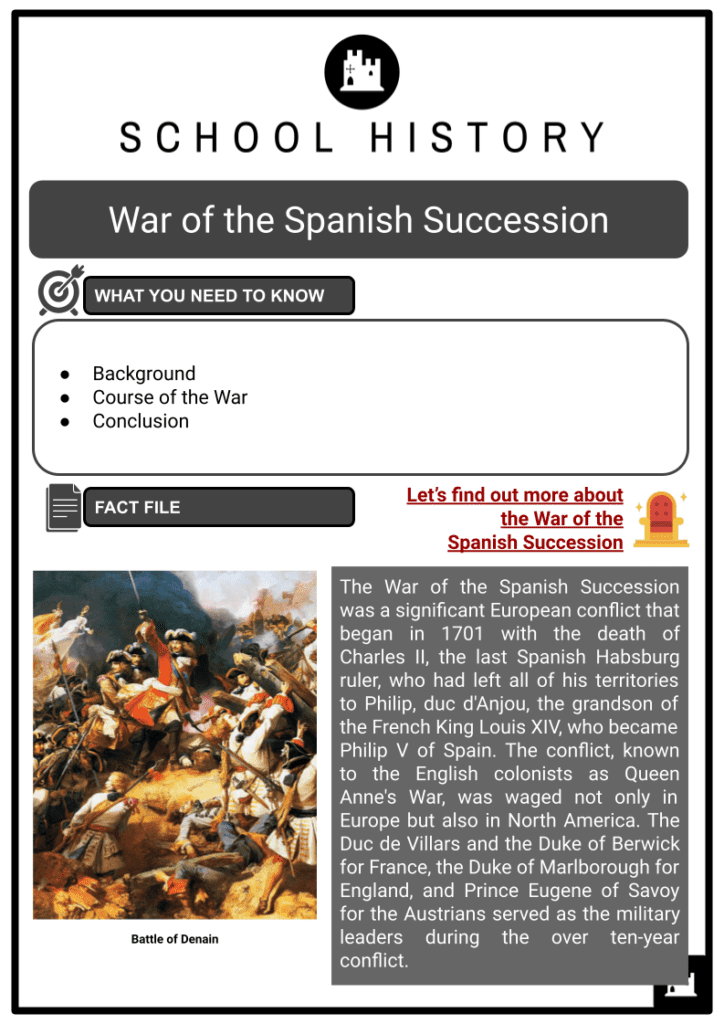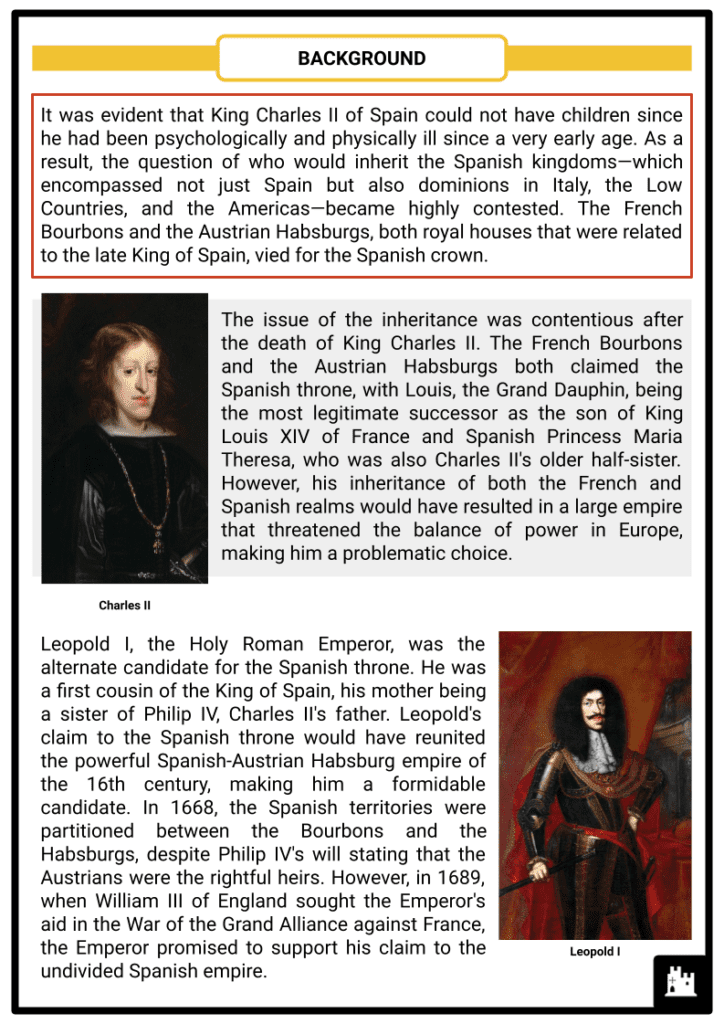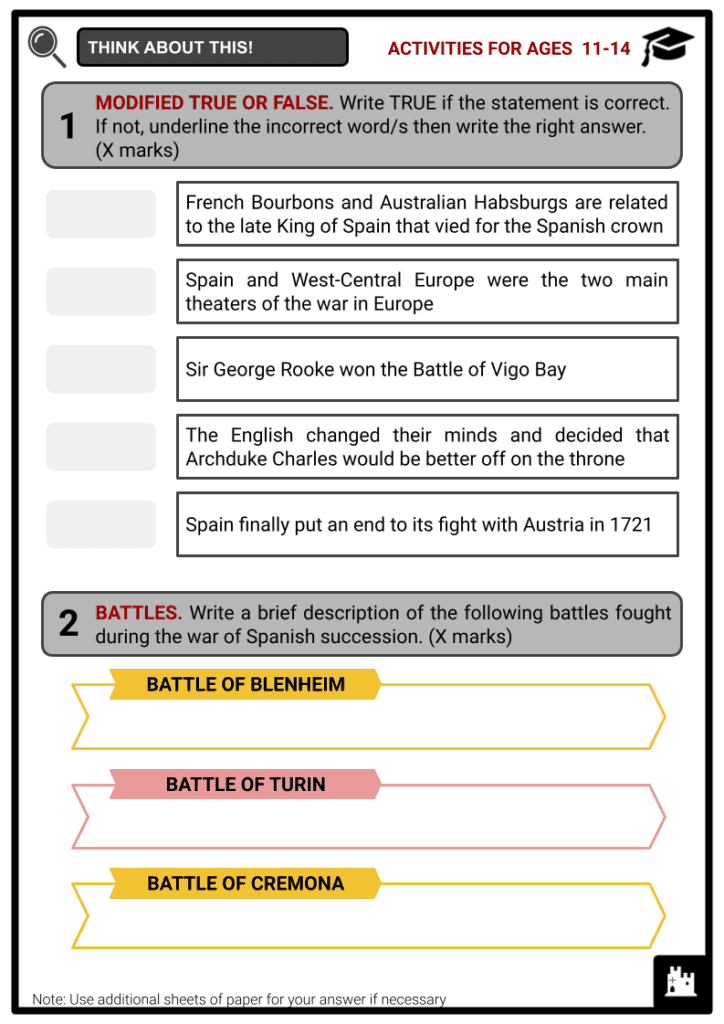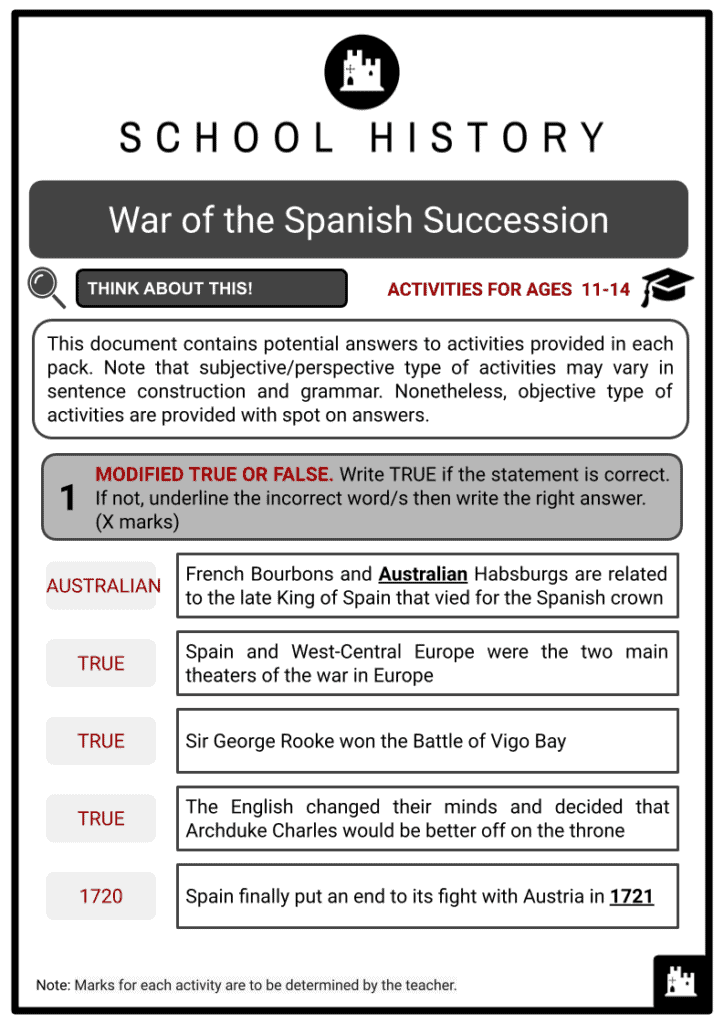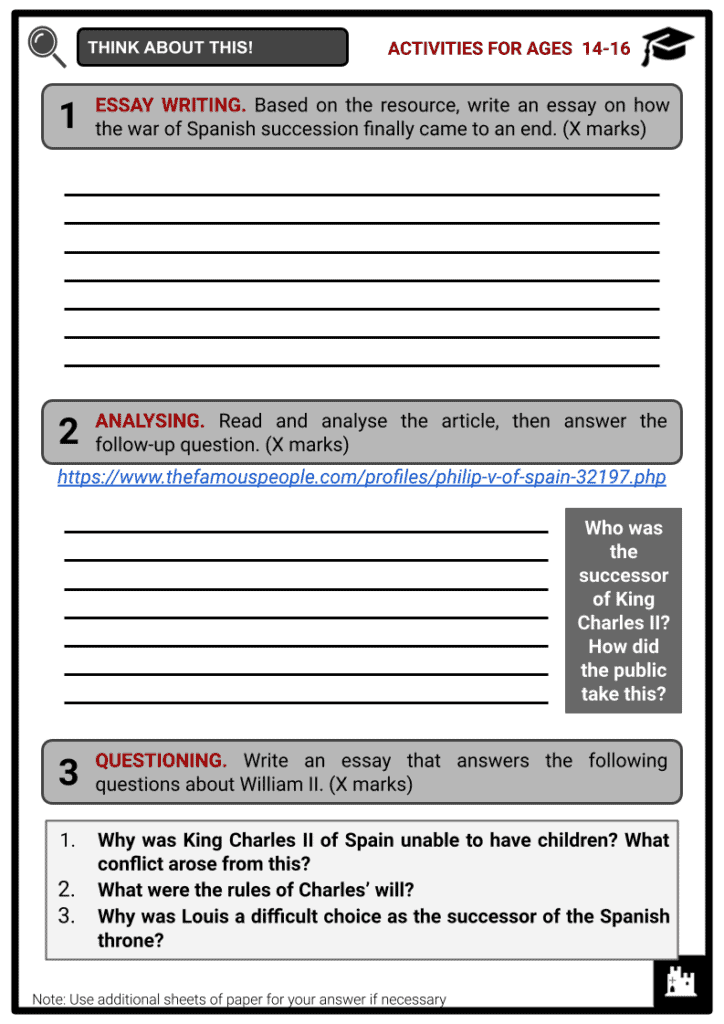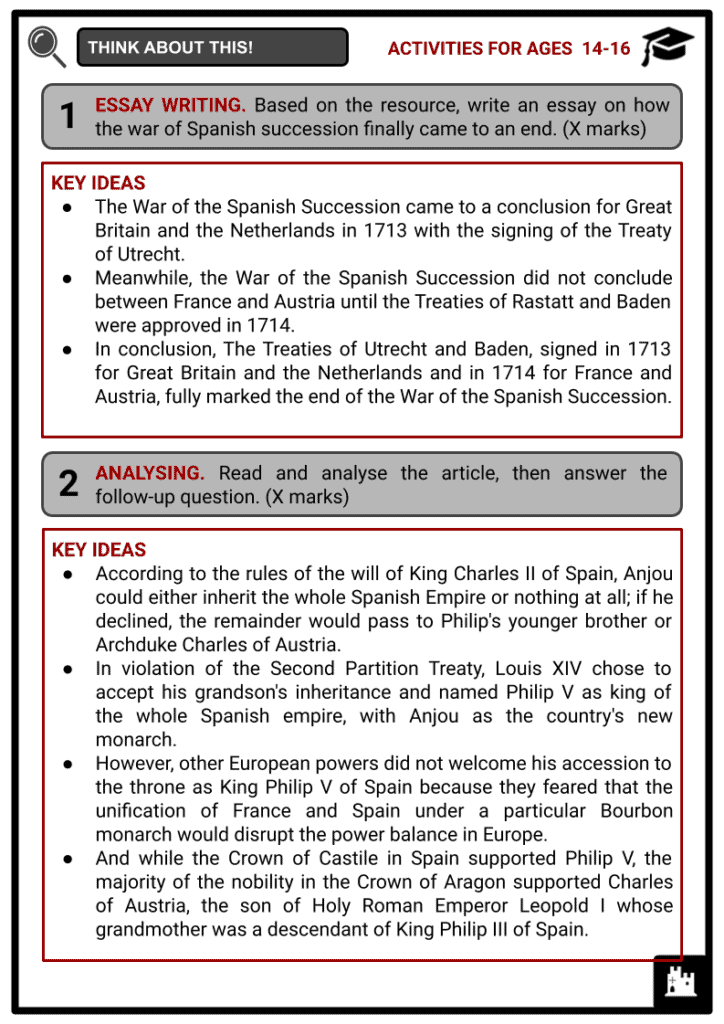War of the Spanish Succession Worksheets
Do you want to save dozens of hours in time? Get your evenings and weekends back? Be able to teach about War of the Spanish Succession to your students?
Our worksheet bundle includes a fact file and printable worksheets and student activities. Perfect for both the classroom and homeschooling!
Summary
- Background
- Course of the War
- Conclusion
Key Facts And Information
Let’s find out more about the War of the Spanish Succession!
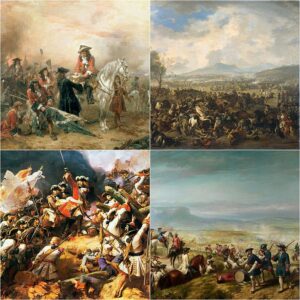
The War of the Spanish Succession was a significant European conflict that began in 1701 with the death of Charles II, the last Spanish Habsburg ruler, who had left all of his territories to Philip, duc d'Anjou, the grandson of the French King Louis XIV, who became Philip V of Spain. The conflict, known to the English colonists as Queen Anne's War, was waged not only in Europe but also in North America. The Duc de Villars and the Duke of Berwick for France, the Duke of Marlborough for England, and Prince Eugene of Savoy for the Austrians served as the military leaders during the over ten-year conflict.
BACKGROUND
- It was evident that King Charles II of Spain could not have children since he had been psychologically and physically ill since a very early age. As a result, the question of who would inherit the Spanish kingdoms—which encompassed not just Spain but also dominions in Italy, the Low Countries, and the Americas—became highly contested. The French Bourbons and the Austrian Habsburgs, both royal houses that were related to the late King of Spain, vied for the Spanish crown.
- The issue of the inheritance was contentious after the death of King Charles II. The French Bourbons and the Austrian Habsburgs both claimed the Spanish throne, with Louis, the Grand Dauphin, being the most legitimate successor as the son of King Louis XIV of France and Spanish Princess Maria Theresa, who was also Charles II's older half-sister. However, his inheritance of both the French and Spanish realms would have resulted in a large empire that threatened the balance of power in Europe, making him a problematic choice.
- Leopold I, the Holy Roman Emperor, was the alternate candidate for the Spanish throne. He was a first cousin of the King of Spain, his mother being a sister of Philip IV, Charles II's father. Leopold's claim to the Spanish throne would have reunited the powerful Spanish-Austrian Habsburg empire of the 16th century, making him a formidable candidate. In 1668, the Spanish territories were partitioned between the Bourbons and the Habsburgs, despite Philip IV's will stating that the Austrians were the rightful heirs. However, in 1689, when William III of England sought the Emperor's aid in the War of the Grand Alliance against France, the Emperor promised to support his claim to the undivided Spanish empire.
- The Electoral Prince Joseph Ferdinand of Bavaria was born in 1692 and was a new candidate for the Spanish throne. He was the grandson of Leopold I, but through the female line, so he belonged to the Wittelsbach dynasty rather than the Habsburg dynasty. Joseph Ferdinand was not a Bourbon or a Habsburg, so the likelihood of Spain merging with either France or Austria was low. He was favoured by England and the Netherlands and would have been the legitimate heir to the Spanish throne according to Philip IV's will.
- The Spanish succession was a pressing issue after the end of the War of the Grand Alliance in 1697. The Treaty of Den Haag in 1698 named Joseph Ferdinand as the heir to the Spanish throne and divided Spanish territory in Italy and the Low Countries between France and Austria. The Spanish were not consulted in this decision and strongly opposed the division of their empire. In response, Charles II of Spain agreed to name Joseph Ferdinand as his heir, but granted him the entire Spanish Empire instead of just the parts chosen by England and France.
COURSE OF THE WAR
- In order to prevent conflict over the Spanish inheritance, Louis XIV's advisors originally persuaded him to accept the provisions of the Second Partition Treaty of 1700. The marquis of Torcy, Jean-Baptiste Colbert, maintained that France would have to battle Austria whether or not they absorbed the entire Spanish Empire. According to the rules of Charles' will, Anjou could either inherit the whole Spanish Empire or nothing at all; if he declined, the remainder would pass to Philip's younger brother or Archduke Charles of Austria. In violation of the Second Partition Treaty, Louis XIV chose to accept his grandson's inheritance and named Philip V as king of the whole Spanish empire, with Anjou as the country's new monarch. In April 1701, William III of England grudgingly accepted Philip as king after being unable to declare war on France.
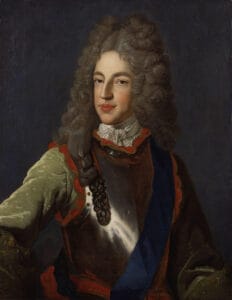
James Stuart - The Treaty of Den Haag was negotiated in September 1701 by Austria, the United Provinces, and England as a result of Louis XIV of France's strategy, which threatened the commercial interests of England and the Netherlands by cutting them off from Spanish commerce. In order to shield the territory from French rule, the treaty acknowledged Philip V as King of Spain and handed Austria the Spanish holdings in Italy and the Spanish Netherlands, while England and the Netherlands kept their trade rights in Spain.
- James Francis Edward Stuart, son of James II, was acknowledged by Louis XIV as the legitimate ruler of England, which sparked conflict with William III and the English populace. After Austrian soldiers invaded the Duchy of Milan, France intervened in the War of the Spanish Succession. While other powers like Bavaria, Cologne, Portugal, and Savoy backed France and Spain, England, the United Provinces, and the majority of German states sided with Austria. Aragon, Valencia, and Catalonia's cortes made proclamations in support of the Austrian Archduke. Under the direction of her ministers Godolphin and Marlborough, Anne, William III's successor, carried on the war.
- Spain and West-Central Europe were the two principal theaters of the war in Europe (especially the Low Countries). Prince Eugene and the English Duke of Marlborough both established themselves as military leaders, although the latter theater turned out to be more significant. Important battles were also fought in Italy and Germany.
- Eugene fought in Italy and won the Battle of Cremona by taking the Duc de Villeroi prisoner. In the Low Countries, Marlborough oversaw joint English, Dutch, and German forces that captured significant fortifications like Liège. At Friedlingen, a French army led by Claude-Louis-Hector de Villars beat an Imperial force led by Louis of Baden. The Spanish treasure fleet was shattered, and tons of silver were taken, thanks to Sir George Rooke's victory in the Battle of Vigo Bay.
- The French and Bavarian army were successful in several battles in Germany, but the Elector of Bavaria's lack of aggression prevented them from attacking Vienna. The French also suffered setbacks in Portugal and saw Savoy defect to the other side. The English, who previously thought it was acceptable for Philip to remain on the throne of Spain, changed their minds and decided that the Archduke Charles would be better for their commercial interests.
- While Tallard and the Franco-Bavarian army marched on Vienna, the French intended to deploy Villeroi's force in the Netherlands to encircle Marlborough. Marlborough and Eugene engaged the French in the Battle of Blenheim in an effort to stop the Franco-Bavarian army from advancing on Vienna. Marlborough and Eugene won the Battle of Blenheim, which also ended the involvement of Bavaria in the conflict. With the assistance of Dutch armies, England seized Gibraltar in Spain in 1704. The Archduke Charles first took part in the conquest of Gibraltar.
- The French were successfully driven out of the Spanish Netherlands, including Antwerp and Dunkirk, by Marlborough and the English and Dutch armies in 1706; meanwhile, Prince Eugene and the Duke of Savoy defeated the French in Italy in the Battle of Turin, forcing them to flee. Little progress was made in any of the combat theaters the previous year as both sides moved hesitantly. With Marlborough's victory at the Battle of Ramillies in May, the deadlock was broken.
- The focus switched to Spain in the years after France's departure from Germany, the Low Countries, and Italy. A Portuguese commander launched an invasion of Spain in 1706 and took control of Madrid, but by the end of the year an army under the command of King Philip V and the Duke of Berwick had retaken the city. Galway led a second effort to seize Madrid in 1707, but Berwick repelled it in the Battle of Almansa.
- Sweden, France, and the Allies all made an effort in 1707 to draw Charles XII of Sweden into their respective conflicts. Charles, however, decided against interfering since he was more concerned in battling Russia. Later that year, the Allies made a failed effort to attack southern France from Italy. Marlborough concentrated on conquering strongholds in the Low Countries while the French army struggled under poor command. Marlborough and Prince Eugene collaborated in 1708 to beat the French in the Battle of Oudenarde before capturing Lille.
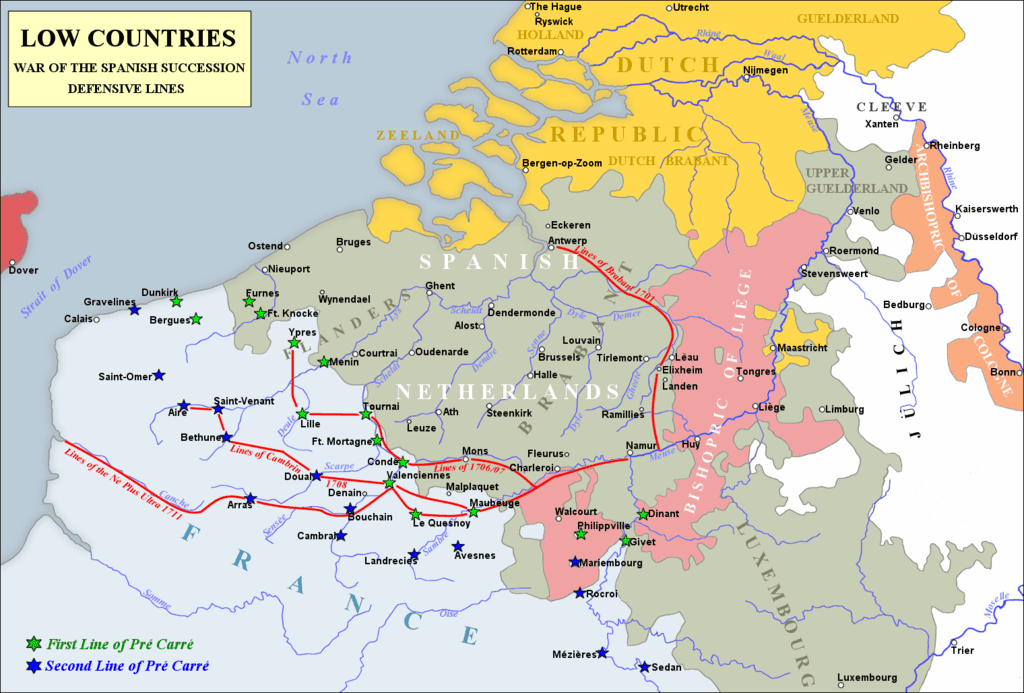
Map of the Low Countries - Louis XIV was compelled to negotiate with the allies after the French defeats at Lille and Oudenarde, but he resisted their proposals to depose his own grandson. Three invasions of France were attempted by the allies in 1709, one of which was commanded by Marlborough and Eugene and ended in the deadly Battle of Malplaquet, which the allies ultimately won but suffered heavy losses in. The failure of the allies to capitalise on their success by launching the invasion after the combat represented a turning point in the conflict.
CONCLUSION
- The allies attempted one last campaign in Spain in 1710 but failed. Marlborough's political power in Britain decreased as the allies' relationship grew weaker. The Whig administration, which backed the war, was overthrown, and the Tory government, which desired peace, took its place. Marlborough was sent back to Britain, and the Duke of Ormonde took his position.
- The War of the Spanish Succession came to a conclusion for Great Britain and the Netherlands in 1713 with the signing of the Treaty of Utrecht. Due to the Duke of Ormonde's refusal to send British soldiers into battle, French successes, especially at the Battle of Denain, were made in 1712. The War of the Spanish Succession did not come to a conclusion between France and Austria until the Treaties of Rastatt and Baden were approved in 1714. After losing the War of the Quadruple Alliance to Austria, Spain did not legally put an end to its fight with that country until 1720. The allies' presence in Spain came to an end in September 1714 when Barcelona, which had backed the Archduke Charles' bid for the Spanish monarchy and the allies in 1705, submitted to the Bourbon troops.
- Early in the 18th century, there was a significant war in Europe called the War of the Spanish Succession that was principally fought between France and the Grand Alliance (made up of Great Britain, the Netherlands, and Austria). The Treaty of Utrecht, which was signed in 1713 between the Netherlands and Great Britain, put an end to the conflict. However, the conflict between France and Austria didn't legally end until the Treaties of Rastatt and Baden were signed in 1714. Prior to its loss in the War of the Quadruple Alliance in 1720, Spain, which had joined the Grand Alliance, continued to battle Austria. The battle resulted in substantial geographical changes as well as an influence on the balance of power in Europe.
- In conclusion, the Treaties of Utrecht and Baden, signed in 1713 for Great Britain and the Netherlands and 1714 for France and Austria, respectively, marked the end of the War of the Spanish Succession.
- France agreed to discontinue backing the Stuart claim to the British throne despite not experiencing any substantial geographical changes in Europe.
- It did, however, let the Dutch keep forts in the Spanish Netherlands and annexe part of Spanish Guelders while giving up certain possessions in North America.
- After the war, France and Spain, both ruled by Bourbon dynasties, continued to be allies, but Spain had far less influence and was reduced to a minor player in continental affairs.
Image Sources
- https://en.wikipedia.org/wiki/War_of_the_Spanish_Succession#/media/File:Final_War_of_the_Spanish_Succession_Collage.jpg
- https://en.wikipedia.org/wiki/James_Francis_Edward_Stuart#/media/File:Prince_James_Francis_Edward_Stuart_by_Alexis_Simon_Belle.jpg
- https://en.wikipedia.org/wiki/War_of_the_Spanish_Succession#/media/File:Low_Countries_1700_and_entrenched_lines.png

